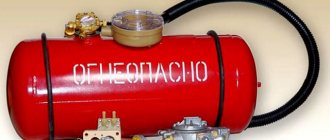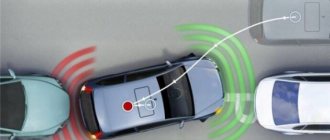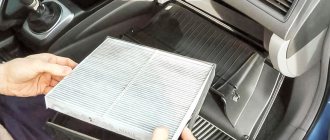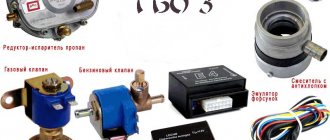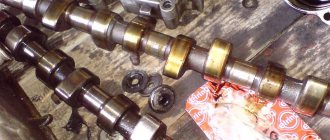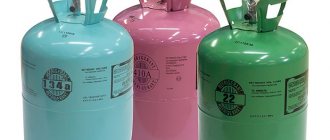Anyone who has installed a 4th generation LPG on a car with their own hands will say that this is a very complex and labor-intensive process. Before you take on this matter, you need to weigh the pros and cons. Feedback and reviews from people who have already tried or installed gas equipment on a car can help.
Briefly about HBO on cars
Before telling you how to choose and install the kit correctly, you need to say a few words about what gas equipment is on a car. This is a set of additional equipment that ensures gas storage, formation, supply and the most complete combustion of the fuel-air mixture in an internal combustion engine. The internal combustion engine can be either gasoline or diesel.
Two types of gas are used in different states of aggregation:
- Compressed natural methane.
- A liquefied mixture of propane and butane obtained by cracking.
After conversion, the power system can be single- or dual-fuel with separate or simultaneous supply of two types of fuel (gas-diesel). Today, the sixth generation of HBO is being introduced, but there are not many differences between the schemes.
Typically, elements of the previous generation are supplemented with new ones, allowing the equipment to be adapted to more advanced engines. If the topic interests you, read more about gas equipment for cars.
Equipment decoration
Like any change in a car, the installation of LPG must be registered with the traffic police. In addition, you should undergo a technical examination in advance and obtain permission to install equipment from the same road inspection. After installing the system, you need to obtain the appropriate certificate. Not all service stations issue the necessary documents. As a result, you will need to collect a package of documents, which includes:
- registration certificate;
- permission to install HBO;
- certificate of conformity of installed equipment;
- installation certificate;
- original and copy of passport and TIN.
This is the required minimum for obtaining rights to use a car for an individual. For authorized and legal entities, in order to register gas equipment for a GAZelle, they still need documents identifying the owner. Which ones exactly depend on the specific case, so this needs to be clarified. A notarized general power of attorney for a car will be required if you are going to transfer the right to drive the vehicle to another person.
For a legal entity, in addition to the above papers, you will need copies of:
- company registration certificates;
- extracts from the register of enterprises;
- company charter;
- agreements with ATP;
- vehicle fleet code.
Depending on the company’s specialization and its size, they may additionally request copies of some documents - this needs to be clarified in each specific case.
What to choose - propane or methane
Having decided to install, the car owner first has to decide which gas to use. The choice is mainly determined by the type of vehicle. As a rule, the installation of gas equipment on trucks, buses and special vehicles uses methane as fuel. This gas is considered more efficient than propane-butane, but has storage requirements that are not very suitable for passenger cars. To contain gas under pressure (up to 300 atm), large and heavy cylinders are needed, which often have nowhere to be placed. It is believed that new motors will not be able to work on it, although the statement is controversial.
Methane is lighter, evaporates faster, and explosive concentrations are reached later (5% versus 2.5%). It is less dangerous in terms of fire, but more harmful to the health of passengers. Its consumption is not much higher, but there is a significant drop in power (up to 15%), despite the fact that the octane number is higher (110 versus 105 for propane). The latter is due to the fact that methane mixes less well with air.
Methane is cheaper, but gas stations are few and far between, and installation can be more expensive. At the same time, the power reserve with this gas will be less, because it will not be possible to pump a large volume. So everyone decides for themselves what is better – methane or propane.
How to combine two cylinders into HBO? Implementation options
- The first method is to install two separate cylinders with their own air pumps. This option is less convenient, but easier to implement. Two cylinders are installed, which are connected through a tee to the central line leading to the reducer. Before inserting into the central highway, you can install one solenoid valve, although many argue that one is enough.
- The second option is to install two gas tanks with one VSU. This option is more convenient, since gas cylinders will be refilled through one device. The connection to the VSU is made through a tee, while some installers remove one multi-valve so that the second tank is filled more fully and acts as an additional tank, while the two tanks are perceived by the system as one. But I would not recommend taking risks by removing the second multivalve; this smart and multifunctional unit is very important.
There are other options, but, in my opinion, these two are the most optimal. The only thing you should remember is that the installation of gas equipment, as well as cylinders in particular, should be done by a professional. Any, at first glance, little things can lead to dire consequences or at least to incorrect operation of the gas equipment. Remember this!
If you know of other options for installing two cylinders in the HBO system, tell us about them in the comments, I will be very grateful.
Bye everyone, thank you for your attention, and see you again at HBOshnik.
Which generation of HBO should I buy?
There are two types of gas cylinder installation for a passenger car:
- Ejector - when gas is sucked in due to the vacuum in the carburetor, mixed with air and then enters the cylinders.
- Injection - when gas is supplied to the engine under pressure through a mixer or specially designed gas injectors.
Accordingly, everything depends on the standard injection system. For carburetor and monoinjection engines, less complex equipment of the first generations is used. For injection engines, as well as with distributed and direct injection systems, more complex equipment with high-precision tuning is used.
The first generation is distinguished by simple controls, which are often absent altogether. The advantages include cost (from $250), unpretentiousness to installation technology and fuel quality. The disadvantages are increased consumption and loss of power. It is used extremely rarely and only on very old cars. You can read more about the advantages and disadvantages of the system in our article “GBO 1st generation”.
The second generation is called the lambda control system. The appearance of this equipment was associated with the introduction of lambda probes on the first injection engines. The system was supplemented with an electronic dispenser (stepper motor), which corrects the gas supply based on signals from a sensor installed in the exhaust system.
As a result, thrust increased slightly and consumption decreased. But the price also increased (from $350). This generation of HBO was widely used on mono-injection and carburetor engines of domestic and foreign production, produced in the 90s. To better understand what the difference is, we recommend reading the article “GBO 2nd generation”.
In the third generation, injectors were added for each cylinder. True, so far only mechanical, but they have already made it possible to reduce consumption and minimize the loss of traction. The system was used on injection engines with distributed injection. The disadvantages include the complexity of installation and operation at a fairly high cost (from $500). Due to the rapid emergence of the fourth generation, this equipment did not have time to become widespread, and today it is no longer produced. For general erudition, we recommend reading about 3rd generation HBO.
The 4th generation was dubbed the gas injector. This HBO covered the entire range of injection engines, with the exception of the newest ones with direct injection. The system includes a separate injector with a control unit, gearbox and electronically controlled gas injectors. Provides maximum efficiency (up to 50%) and minimal loss of engine power with distributed injection (2-10%). This is the most common gas equipment today (about 90% of installations), despite the high cost (from $600).
The fifth generation was created specifically for direct injection engines. In this case, the state of aggregation of the gas at the entrance to the engine does not change; it enters the cylinders in liquid form.
If the fourth generation requires a well-heated gearbox and gas, then there is no gearbox and there is no need to cut into the cooling system. There is virtually no power loss. According to some users, it is even growing, as is the price of HBO. The cost of the fifth generation starts at $1.3 thousand, but the consumption will not be much more than on gasoline.
The sixth generation has gone even further - it uses a standard injection system. There is no gearbox or gas injectors. Instead, an electronic fuel selector with a valve block is installed in the fuel line. This solution allows you to achieve quick start on gas, increase car dynamics and smooth engine operation.
The price starts at $2 thousand, but is partially compensated by driving efficiency (consumption is only 10-15% higher than gasoline) and reduced maintenance costs due to less clogging and condensation formation. As experts note, this generation ensures a 20% reduction in harmful emissions.
How much does it cost and where to buy?
The amount that the alteration will cost consists of the price of a set of equipment, a cylinder, wages for installers and the cost of legitimizing this large-scale alteration of the car. Installing a simple turnkey system costs 30–50 thousand rubles. The price depends on the number of cylinders in the engine and the size of the cylinder. You can find a lot of online calculators on the Internet: enter the price of the conversion, fuel consumption and data on the mileage of your car - at the end you get the payback period for such a conversion.
If finances allow, it is better to purchase a gas installation made in Italy or Holland. Domestic and Polish companies complete the kits with less expensive components; their installations are 5–10 thousand rubles cheaper, but immediate savings can result in repair costs in the near future. The cylinder is usually purchased separately. In this case, you can trust the domestic manufacturer: Russian cylinders are cheaper than imported ones, but the quality is no worse.
A toroidal cylinder is comfortably located in the trunk's spare tire niche. There is only one drawback to this scheme: the spare tire will take up space in the trunk. |
The filling valve is located under the gas tank filler flap. Some people hide it in the depths of the trunk or put it under the bumper. |
The most convenient and reliable solution is to purchase gas system components directly from the installer. You may be able to find an LPG kit cheaper on the side, but then if problems arise during operation, the installer can blame the equipment manufacturer, and so all claims are covered in one window. In addition, the warranty in such cases is often longer - for large companies it reaches up to five years.
What is needed before installing HBO
Technical Regulations of the Customs Union TR CU 018/2011 “On the safety of wheeled vehicles” defines the installation of gas equipment as an intervention in the design of the car. According to Art. 12.5, part 1 of the Code of Administrative Offenses of the Russian Federation, operation without registering changes in the traffic police is prohibited and punishable by a fine.
Before installing the equipment you must:
- Conduct a preliminary examination to determine technical feasibility.
- Submit an application to the traffic police for the conversion of the vehicle, indicating the organization that will deal with it and the deadlines. You will also have to provide a package of certain documents.
Where should HBO be installed?
Now about where you can install gas equipment. This must be done by a licensed organization:
- Our specialists will do the work efficiently, in full accordance with accepted technologies.
- Relevant documents will be issued, including copies of licenses and equipment certificates that may be needed by the traffic police.
- The same company will perform the necessary periodic maintenance and inspection of the gas equipment.
- Legal installation in a certified center will save you from problems and financial costs in the future, and in some cases can even save lives. In any case, you won’t pass the examination in a garage, and you can’t go anywhere without it.
Do-it-yourself installation
A couple of comments on the topic of whether it is possible to install gas equipment on the car yourself. Of course, yes, if you do not take into account quality and safety.
The procedure is not that complicated. If the car is not new and not the most expensive, you can save on installation. At the same time, it is unlikely that it will be possible to achieve high accuracy of equipment settings. But you can make a mistake, so all the work will go down the drain. It is also necessary to take into account that all registration actions and subsequent maintenance must be carried out in accordance with the law.
What equipment is suitable
Currently, there are already several generations of gas equipment. They differ in the complexity of installation and configuration, as well as in price and degree of automation. For most cars, in particular GAZelle, the choice lies between 4th generation and 2nd generation LPG.
| Generation 2 | Generation 4 | ||
| pros | Minuses | pros | Minuses |
| Price | Morally obsolete | Manufacturability | Price |
| Easy to install | Most settings need to be done manually | High accuracy of fuel dosage | Difficulty of installation |
| Minimum electronics | Minimum control elements | Automatic control of system operation | Expensive repairs |
| Cheap repairs | Low tuning accuracy | Low consumption and high payback | |
| High reliability | Low technology | Maintaining vehicle speed characteristics | |
When choosing equipment, keep in mind that the 2nd generation LPG for an injection system on a GAZelle is better suited than for a carburetor system.
Thus, if the priority is the low cost of installation, maintenance and spare parts, as well as ease of installation, the second generation of gas equipment is for you. But then you sacrifice tuning accuracy and the dynamic characteristics of the car. If convenience, power retention and manufacturability are important, choose a higher generation. But get ready to spend from 500 to 1000 euros on the system (the second generation will require about 200 euros).
Installation algorithm
Now let’s move on to the most important thing and tell you how to correctly install gas equipment on a car, regardless of generation:
- Before installation, locations for the cylinder, lines and other elements of the system are determined.
- Clamps, fittings, hoses, adapters and connections are selected based on actual measurements.
- The gearbox is installed and high-pressure lines are laid in the engine compartment.
- The connection is made into the cooling system and connection to the system.
- Gasoline and gas valves are installed. If you are installing an LPG on a carburetor car, the first is cut into the fuel hose between the pump and the carburetor on the left side of the engine compartment, and the second - opposite.
- The remaining lines and elements are installed.
- The regulator and/or ECU is mounted.
- Connections are sealed.
- The electrical part is connected.
- Startup and setup in progress.
If gas equipment is installed on a car of the latest generations, at the first stage the pump is mounted (on the frame), and the insertion and installation of nozzles is carried out before connecting the electrical part.
The installation procedure for gas cylinder equipment when installing it on a car
After selecting gas equipment, you can begin installing it in the car. See detailed video instructions for installing 4th generation gas equipment below.
Before starting the installation, you need to decide on the mounting locations for the filling valve (usually under the bumper or in the area of the gas tank filler neck) and the fuel switch button (gas/petrol) in the car interior.
During the installation of gas equipment, the battery must be disconnected from the vehicle's on-board network!
The first element of gas equipment that is installed on a car is a gas reducer . Its task is to reduce gas pressure and maintain constant pressure at the outlet of the reducer. The gearbox itself is mounted on fixed and stable elements in the engine compartment.
Then rubber hoses are connected to it, through which antifreeze is supplied from the engine cooling system to heat the gearbox during operation. In most cars, the connection to the cooling system should be in parallel, that is, between the engine block and the heater radiator (the so-called small circle).
Next, they usually install a solenoid valve , which is also attached to the car body (preferably as close as possible to the gearbox).
an electronic control unit or, as it is also called, a controller is mounted and connected To perform such work, you must have basic knowledge of the electrical system of a car and have a wiring diagram for the electronic gas control unit.
To simplify the task, you need to find a place in the car's wiring harness where you can simultaneously find all the signals:
- Signal from oxygen sensor (lambda probe);
- Petrol injector signal;
- Engine speed.
If you have a simple lambda probe, you need to connect to the signal wire in parallel (directly), and if a UEGO broadband probe is installed in the car, then you should connect in series by cutting the signal wire (see the video below).
Wiring to gasoline injectors can be done using a connector, or by soldering into the wiring harness. Typically, two electrical wires run from the fuel injection control unit to gasoline injectors: power and signal. To solder into the wiring, you should find the signal wires of the injectors, cut them and connect them according to the diagram.
The next signal that the gas control unit needs is engine speed. It can be found in the ignition coil wiring harness.
fuel switch is installed in the driver's cab. Several wires are connected to it:
- “Plus” from the ignition switch: voltage on this line should appear when the ignition is turned on, and disappear when it is turned off;
- Wires from the 16-pin OBDII diagnostic connector, according to the connection diagram.
In order to accurately determine the contacts of the OBDII diagnostic connector necessary for connection, a car scanner is first connected to it. Read more about what a car scanner is and how it can be useful to you here.
A very important operation when installing automotive gas equipment is drilling holes in the intake manifold for fittings (screws) from gas injectors. It is important that the holes are made in such a way that the fittings screwed into them are at the same angle as the gasoline injectors.
In the holes obtained in the intake manifold, threads are cut for gas fittings, and before screwing in the fittings themselves, a special sealant that is resistant to high temperatures is applied to their threads.
After screwing the fittings, gas hoses are put on them, which, in turn, are connected to gas injectors. These hoses must be the same length.
Gas injectors are designed to dose gas directly into the engine intake manifold. They are usually located on a common ramp and are mounted in close proximity to the engine intake manifold. Connecting the electrical connectors to the injectors is carried out in the same sequence as the connection of gasoline injectors previously made at the factory. In the photo below you can see the connected block of gas injectors.
The final purification of the gas entering the nozzle is provided by a vapor phase filter . It is installed directly behind the gearbox and is connected with an input to it and an output to the gas injector block.
Next, a hole is drilled in the common part of the intake manifold for a fitting for vacuum selection , after which a hose is put on the fitting screwed into it, which connects to the vacuum pipe of the gas reducer to regulate the performance of the latter.
The gas cylinder is usually selected based on the size of the spare wheel niche. In the niche there are two holes for bolts for attaching the cylinder and one large hole for the ventilation breather. To avoid corrosion, the resulting holes are treated with an anti-corrosion compound.
Before fixing the gas cylinder in the niche of the car, a multivalve . This unit is mounted in such a way that the gas level float moves from bottom to top. Next, the cylinder is placed in a niche and secured with two bolts.
The following are connected to the multivalve:
- Gas pipe (inlet) from the filling valve;
- Gas pipe (outlet) to the solenoid valve;
- Electrical wires for level indication and from the solenoid valve.
The ventilation breather is designed to remove possible gas leaks to the outside of the machine. It is inserted into the lower part of the gas cylinder and screwed to it with self-tapping screws, and from the bottom it is sealed so that water does not get under the cylinder.
When the main parts of the gas equipment are installed in the car, you can begin installing the gas pipes according to the installation diagram. All gas pipes are attached using metal clips and screws.
Electrical wires of the solenoid valve and gas level indicator are laid along the laid gas line, which are secured with clamping plastic ties.
At the final stage of installing LPG, a filling device (valve) is mounted on the vehicle. Three holes are drilled in a pre-selected location for this: one for the valve itself, and two for its fastening. After connecting to the gas pipe, the valve is installed in place and secured.
After completing the installation of gas equipment, a diagnostic scanner is connected to the gas control unit, which checks the correct reading of all parameters and performs auto-calibration of the equipment. Then, while the engine is running on gas, all connections are checked for leaks.
And in order for the car to operate correctly on gas fuel in any situation, it is necessary to configure the gas control system while driving (the so-called multiplier adjustment).
Installing LPG from professionals is a guarantee of savings and your safety. Only specialists who have undergone appropriate training can correctly install and configure gas equipment on a car.
In the video below you can clearly see the professional installation of gas equipment on a car and its configuration in a certified service center.
Inspection of gas cylinders
Penalties are provided for ignoring periodic inspection of gas equipment. After installation, the organization issues a passport and certificate for the gas cylinder with signatures and seals of the manufacturers. The passport indicates that the cylinder has passed a pneumatic pressure test at the company that manufactured it.
The dates and results of subsequent examinations are also entered in the passport. The owner of a propane-butane gas equipment has the task of checking the condition of gas equipment and cylinders every two years. For methane cylinders, the timing depends on the material of manufacture:
- alloy steel – once every 5 years;
- carbon steel – once every 3 years;
- polymers – once every 2 years.
Based on the inspection, a certificate in form 2B is issued, without which you may be fined and not even refilled. This is an important part of the service, so it is worth studying how gas cylinders are inspected.
How to connect two gas cylinders to one LPG system?
Installing gas equipment has a lot of different subtleties and secrets, without knowing which you can make a lot of mistakes. Every mistake during operation will lead to interruptions in engine operation or, worse, to an accident.
It is for this reason that most of us trust the installation of gas equipment to specialists who have the necessary equipment and experience to perform everything to the highest standard. However, situations often occur in which even experts find themselves at a dead end. So, for example, not many installers know how to properly connect two cylinders so that the system functions correctly and fully.
In this article, I will try to answer the question of how to connect gas cylinders to each other and correctly organize an LPG system that includes two cylinders.
What documents are needed for HBO
When registering with the traffic police, the following documents will be required:
- statement;
- expert opinion;
- passport;
- power of attorney, agreement/other document certifying the authority to represent the interests of the owner;
- SOR and PTS;
- Forms 2A and 2B, copies of equipment certificates and licenses of the installer company issued by an accredited certification center;
- diagnostic card;
- receipt of payment of state duty.
The issued certificate of conformity and a passport for LPG with marks must be kept in the car.
Before visiting the traffic police, it is important to have a complete understanding of how to obtain the necessary documents for LPG and for a car.
Registering HBO with the traffic police
After installation of the equipment, an acceptance certificate and a declaration on the volume/quality of work performed are issued, with which, after technical inspection, you must again go to the traffic police. Only now with a statement requesting changes due to a design change. According to the Order of the Ministry of Internal Affairs of December 7, 2000 N 1240, based on the results of the re-examination, they are required to issue a certificate of compliance of the vehicle design with safety requirements, a new SOP and make notes in the PTS. The procedure sometimes changes, but in order not to waste time, before starting the procedure, you can ask how the registration of HBO is carried out in the traffic police.
Installation of gas equipment on a VAZ
Installation on VAZ models, carburetor and injection, does not have any special features. In the latter case, it is not a gas valve that is used for cutoff, but an injector emulator, which prevents the standard computer from going into emergency mode. A lambda probe emulator is also used.
There are nuances when working with the Niva, which has a small trunk. You can install a gas cylinder on the roof or under the bottom. Installation on VAZ 21214 and 21213, which have a shortened muffler, is somewhat complicated. Any generation of gas equipment is suitable, but for the fuel-injected Niva it is optimal to install a Gromyko gas injector with one nozzle.
The domestic GIG 3 DL and imported ejector systems perform well. For cars manufactured after 2011, an ECU with a program that takes into account the type of injection and road conditions is required.
Read about installing LPG on a VAZ.
Installation of gas equipment on methane
Converting a car to methane gas is practically no different. There is no point in saying that at high pressure, connections and hoses must be of appropriate quality. Additionally, a system pressure gauge is installed on the gearbox. The technology and operating algorithm are approximately the same. The only difficulty is in the placement of the cylinders. Before you decide to install this system, familiarize yourself with all the advantages and disadvantages of methane gas equipment.
Dismantling of gas equipment
Sometimes, however, owners decide to dismantle gas equipment on their cars. Full or partial restoration can be considered. In the first case, everything returns to the “factory” state.
If you plan to use the HBO in the future, it is simply deactivated by turning off the power supply (remove the fuse) or:
- Remove the balloon.
- They are jamming the highway.
- A plug is installed in the control connector.
Now about how to remove a gas cylinder from a car. It is better to entrust this to a specialist, but you can do it yourself. Usually they just start the engine and wait until it is completely exhausted. Although it can be done differently.
It is very important to de-energize the system, then close both valves (on the cylinder body), unscrew the two braided copper tubes and completely bleed the gas. All you have to do is install the plug, unscrew the fasteners and pull out the cylinder. To completely remove the HBO, you need to:
- Completely release the gas.
- Disconnect the electrics (remove the terminal from the battery).
- Disconnect the lines, remove the cylinder, reducer, ECU and sensors.
- Unscrew the injectors.
- Plug holes in the intake manifold.
- Replace the cooling system pipes.
- Plug the neck.
We hope it is now more or less clear how to remove gas equipment. But we don’t recommend doing it yourself. Although, if you take into account the cost of dismantling at a service station (an average of 4 thousand rubles for a four-cylinder car), you might think twice about it.
